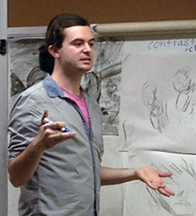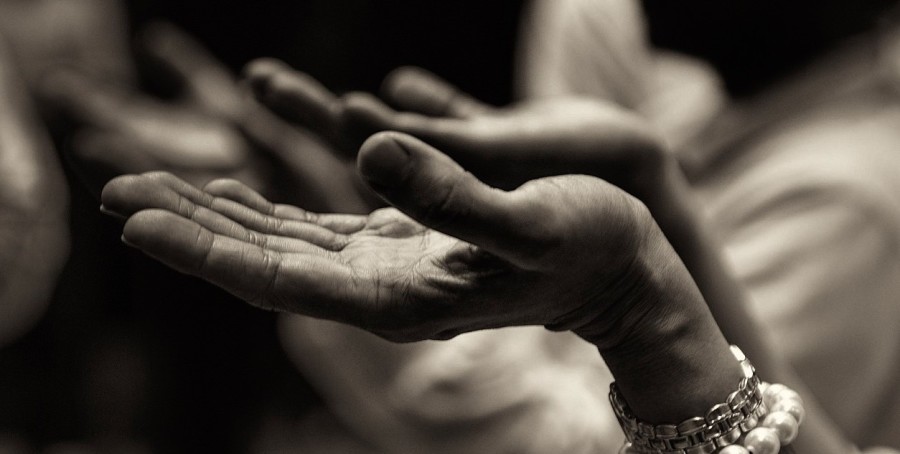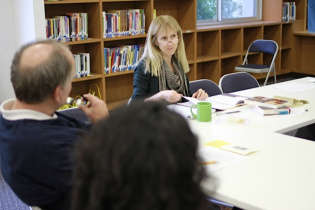Sarah Guayante, a student at St. John’s University and a T&W editorial intern, is interviewing teaching artists who take part in the TATIP* program. Philip Berezney, a multi-disciplinary artist working with Grand St. Settlement, 92nd Street Y, and Wingspan Arts attended the Teaching for English Language Learners seminar facilitated by Holly Fairbank of Center for Arts Education and the Maxine Greene Center. Jordan Dann, education director at Teachers & Writers Collaborative, joined in for the latter half of the interview.
Teachers & Writers: How do your roles as teacher and artist overlap? Does your work as a teacher influence your work as an artist?

Philip Berezney: I have always been passionate both about working in the arts and education. For a long time, I’ve felt like it was a choice: pick one or the other. Pursuing a life and career as an artist and as a teacher are two such demanding paths to follow that sometimes it feels like I can’t fully commit to one while I’m still trying to spin wheels on the other. As I continue to pursue work as a teaching artist, I’ve really started, especially over the past year, to recognize how that position facilitates my ability to pursue both passions. Part of my role as a teaching artist is that I’m encouraged and expected to have my own creative project as a practicing artist.
I do so much research for the curriculum and the lessons I plan that I find I’m constantly influenced by the artists I look at with my students. The process of developing curriculum helps me identify my own interests. Then, as I seek to address topics in a way that will interest all of my students, it ends up expanding some of the information I might have about one of my own interests.
T&W: Can you think of a specific time in which your preparation for the curriculum has inspired or informed some sort of project that you were working on?
PB: I teach middle school-ers twice a week with Grand St. Settlement, and we’re just finishing up a unit that I taught them on line and figure drawings. So, we started looking at artists who work with contour line. We looked at particularly Ellsworth Kelly and David Hockney. Then, we moved to focus on showing value and working with shading with pencils. We looked at a lot of different artists who made drawings, as well as some photographs of hands. We moved on to looking at Georgia O’Keefe and photographs of her hands taken by Alfred Stieglitz. We looked at some Kiki Smith drawings.
For the second part of the unit, I was interested in artists who showed the body and movement as an exciting and complex way to investigate figure drawings. I ended up incorporating a day where I just showed my students some videos of postmodern to contemporary dance artists. Through that research, I started looking at Trisha Brown’s work and discovered that, not only did she work as a choreographer, but she also has a line of her own work that’s focused on drawings. So, I ended up showing my students photos of some of the drawings she made and, through that research, became really interested in some of her practices of dance as drawing that have become incorporated into a current rehearsal process that I’m involved in.
T&W: When you’re in the classroom, what are the most important things about making art that you want to communicate to your students?
PB: It’s really important to me that students in my classes begin to learn ways to identify their own creative input. I’ve found that can be a more difficult task as a teacher than it seems at first.
T&W: In what way?
PB: It stems from the value that I place on creative expression and seeing art as an expressive outlet. But I have found that, through time and working on that goal with different age groups, sometimes students are not used to being given opportunities to make their own decisions. It’s not necessarily enough for me to just bring materials and freedom, but sometimes it really takes some careful structuring of the way that I scaffold that goal. That kind of expressive or individualized directive seems like it should just kind of come naturally, though I have found that it needs to be carefully taught.
T&W: How do you go about approaching that scaffolding?
PB: I try to combine opportunities where students are building specific skills with opportunities that are more open-ended and find that having both opportunities can support both lines of growth. I’m also trying to make sure there are opportunities for students to be talking about the creative process and reflecting on their own artwork, the processes they were involved in, and what they are seeing in other students and other artists that we’re looking at. I find that that language and the process of identifying different strategies through language starts to support those fields and the recognition of, “Oh, I have my own ideas and I can take the initiative to develop them.”
T&W: In your experience, what does including arts education in the curriculum give to students?
PB: So much. With so much focus in schools and so much pressure on academic standards, I feel like students need opportunities to discover learning on their own. I think that happens through the creative process. Like I’ve said, sometimes it takes a more specific effort to actually make that happen than one might think. Sometimes people outside of arts education may not understand what it takes to incorporate what seem like more open-ended expectations. For me, the most important thing about incorporating arts education in the curriculum is that students are given opportunities to get behind their own learning and support their learning through their own interests.
T&W: You’ve talked a lot about students being open-ended in the classroom and students having a lot of independence. I wonder if you’ve ever run into a problem where a student felt uncomfortable with that open-endedness and, if you have, how did you work through that?
PB: Yeah, I find that a lot. Like I said, I think this is a situation students do not often find themselves in. It takes time and patience, continuing to give students that freedom and offering the support through different ways of incorporating conversations. I find that language and dialogue is so often the way that we initiate new ideas in learning. It’s often a part of my strategy to help students discover these new ways of operating, more independent ways of investing in learning and thinking. This seems really basic or simple, but I talk about learning. Learning is one of my expectations in the classroom from the get-go. I introduce that idea as soon as I introduce myself and my class. It’s not just, “We have all these great art supplies do whatever you want,” but ensuring that it’s equating the creative process with the process of learning.
T&W: What sparks your lesson plans? Are there any resources that you use that you would recommend to other teaching artists?
PB: I’ve been doing a lot of work recently with the pre-K through first grade age group. A website that I really love and that I’ve been recommending recently is called The Artful Parent. It’s a blog that a parent started who does a lot of open-ended, process-based activities with her kids at home. It’s a great resource for me as I’m trying to find ways for young students to engage with open-ended processes that also result in some kind of product that we can talk about and share.
When I’m working with older students, I feel like those classes are more inspired sometimes by the artwork that I’m inspired by personally. At least once a month, I try to go see some art galleries in Chelsea. I also have a backlog of art history that I picked up through high school and college, etc. I’ve been trying to focus on incorporating more varied perspective and contemporary perspective into my own work.
T&W: What was one way in which the English Language Learners (ELL) TATIP seminar informed your teaching?
PB: I found that in that seminar, I really appreciated the variety of ways that Holly demonstrated cataloguing language and keeping verbal documentation and visual documentation of language. I have done a fair amount of work with ELL students, and I know how important it is to incorporate language and vocabulary and visuals. It was really great to see that done in a variety of ways during the course of one session.
T&W: What are some of the ways that you’ve incorporated some of those techniques already?
PB: Since the training, I ended up leading a professional development training for Wingspan teaching artists and their staff. It was a training on classroom management strategies and I made sure to incorporate visual cues for the language I was using during my workshop. I printed out in big letters the words that I was going to be talking about, left them up in the classroom, and found it really helpful to have those visual teaching tools at my disposal. I felt that it made it really easy to get everyone on the same page when I was talking about something that not everyone might have been familiar with.
I just finished a residency through 92nd Street Y working at a school in Sunset Park with English language learners. One thing that I have really focused on through that work is making sure that I have an eye-catching visual schedule for my lesson period. The beginning of my lesson involves going over our schedule for the day and that’s something that I really started focusing on through work with ELL students that has also been very useful in all my training.
T&W: We did a spotlight with Amina Henry, who’s just written a play about classroom teachers that has been inspired by a school she was working in. I was just curious: In your own practice, did you find anything in a teaching moment that then became a piece of your own?
PB: I decided that it was important to teach a pretty traditional unit on contour line drawing and value drawing and figure drawing. But I wanted to find ways to both emphasize the importance of engaging in what might seem like a kind of dry, traditional practice with more vibrant and contemporary ideas. I found that I wanted to incorporate experimental dance in this unit on figure drawing, where I planned to show students Edgar Degas and his sketches of dancers. Then, I wanted to combine it with some more vibrant contemporary examples, looking at the work of Trisha Brown. We also looked at the work of William Forsythe, and I showed a really great video to my students that he created with his company. I was really struggling to find a contemporary artist that I could compare with Edgar Degas, and I ended up discovering this artist Lynette Yiodam-Boakye. Her work became a really great parallel to Degas and thinking about these ideas of traditions in art practice versus experimentation. All of those ideas from that unit became incorporated into this performance process that I’m currently engaged in that is incorporating movement and experimentation, and that then started to incorporate different ways of involving a drawing practice.
T&W: I love the idea of drawing dancers because you are supporting a practice of a really high level of observation, of having to embody and notice that form, which takes it into the body in a way that would seem like it’s easier to take the physical shape.
PB: I was really excited by my own process of curriculum development. I’m just recalling that there was a moment that was shocking to me. We had done some contour line drawing and we were having those students draw their own hand. It’s a pretty old-school assignment to give students, and we had some conversations about how some of this unit might be boring and it might be challenging, but I think there are ways that it’s really important to developing skills. Then, I showed an Yvonne Rainer film. It’s a black-and-white film of her hand, after some kind of surgery or medical process that she went through where she just couldn’t move very much. I showed it to my students while they were doing a free-draw as a warm-up for the lesson. Then, I asked them what they thought about it, without telling them anything about where the film was coming from. They all were so engaged with this discussion to decide what it was or what was strange about it. They said it might have been a video that was created to help artists practice drawing hands. Then, the assignment for the day was to make a detailed drawing of your hand. After engaging with this video, they all sat for a full hour in silence and made these incredible drawings. I was so struck by how my choice to incorporate this other art form became a way that I was witnessing this really deep and different engagement with the subjects that they had struggled to connect with the week before.
*The “TATIP Cohort” is part of Community-Word Project’s eight-month Teaching Artist Training and Internship Program (TATIP). This select group of New York City arts education organizations is a partnership initiative to expand professional development not only for the TATIP students, but also for teaching artists working with these organizations. Our mission is to combine efforts to better prepare artists to bring arts to city classrooms. With professional development seminars that deconstruct the dynamics of teaching artistry in a variety of settings and focus areas, the January-May Saturday sessions are geared towards developing new ways of stimulating creativity and understanding in students.
The TATIP Cohort partners with Community-Word Project include:
Brooklyn Arts Council
Center for Arts Education
DreamYard Project
FreeArts NYC
MagicBox Productions
Marquis Studios
Maxine Greene Center
National Dance Institute
New Victory Theatre
Teachers & Writers Collaborative
Wingspan Arts
Voices Unbroken
Teachers & Writers Magazine is published by Teachers & Writers Collaborative as a resource for teaching the art of writing to people of all ages. The online magazine presents a wide range of ideas and approaches, as well as lively explorations of T&W’s mission to celebrate the imagination and create greater equity in and through the literary arts.



